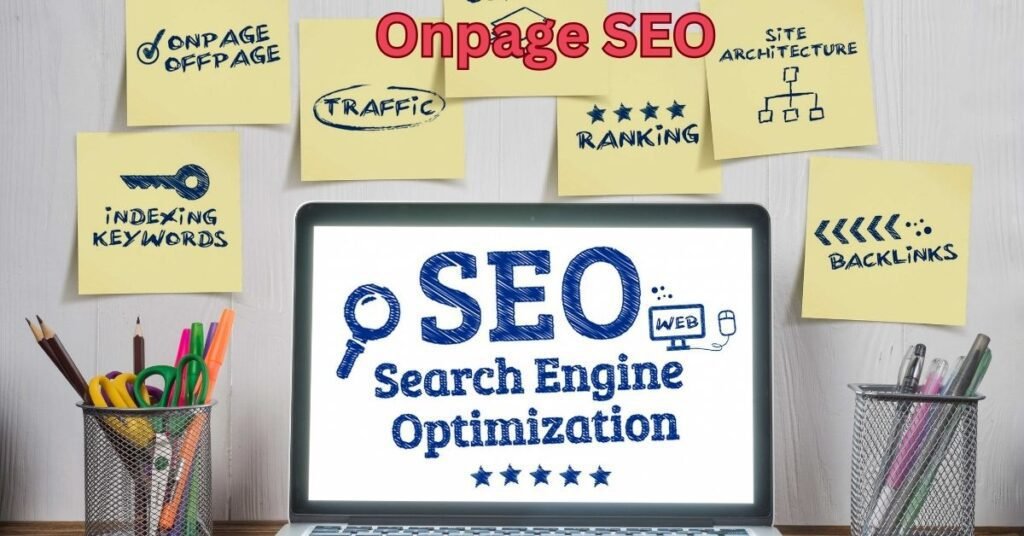On-page SEO is the practice of optimizing the content and code of your website to improve its ranking in search engine results pages (SERPs). It is one of the most important aspects of On-Page SEO, as it can help you attract more traffic to your website and improve your visibility online.

Many different factors contribute to on-page SEO, but some of the most important include:
Keyword research: The first step to on-page SEO is to conduct keyword research to identify the keywords that your target audience is using to search for information online. Once you know your target keywords, you can use them throughout your content, in the title tag, meta description, and other important places on your website.
Content: The quality and relevance of your content is one of the most important factors for on-page SEO. Your content should be well-written, informative, and relevant to your target keywords. It should also be unique and original, as duplicate content can hurt your rankings.
Title tags: The title tag is the text that appears at the top of your browser tab and in search engine results pages.
It is important to make sure that your title tags are relevant to your content and include your target keywords.
Meta descriptions: The meta description is the short snippet of text that appears below your title tag in search engine results pages. It is important to make sure that your meta descriptions are relevant to your content and entice people to click on your link.
Internal linking: Internal linking is the practice of linking to other pages on your website from within your content.
This helps Google and other search engines understand the structure of your website and the relationships between different pages.
Image optimization: Images can also be optimized for On-page SEO. Make sure to include alt text for all of your images, and use descriptive file names.
Technical SEO: Technical SEO refers to the underlying code and structure of your website. This includes factors such as page speed, mobile-friendliness, and security.
By following these tips, you can optimize your website for on-page SEO and improve your ranking in search engine results pages.
Here are some additional tips for on-page SEO:
Use keywords throughout your content, but don’t overdo it. Keyword stuffing can hurt your rankings.
Use long-tail keywords. Long-tail keywords are more specific and have less competition than short-tail keywords. This means that they are easier to rank for. Use synonyms and related keywords. In addition to your target keywords, you can also use synonyms and related keywords.
This will help you reach a wider audience. Use keyword research tools. There are several keyword research tools available that can help you make the process easier.
Track your results. It is important to track your results so that you can see what is working and what is not. This will help you optimize your on-page SEO efforts over time.
Optimizing your website for search engines, also known as search engine optimization (SEO), is crucial for improving your site’s visibility and ranking in search results. Here’s a step-by-step guide to help you optimize your website for search engines:
-
- Keyword Research:
-
- Identify relevant keywords and phrases that potential visitors might use to find your content or products.
-
- Use keyword research tools like Google Keyword Planner, Ahrefs, SEMrush, or Moz Keyword Explorer to discover high-traffic and low-competition keywords.
-
- Keyword Research:
-
- On-Page Search Engine Optimization:
-
- Title Tags: Use unique and descriptive title tags for each page, incorporating your target keywords.
-
- Meta Descriptions: Craft compelling meta descriptions that summarize your page’s content and include keywords.
-
- Headers (H1, H2, H3): Organize your content with headers and use keywords naturally within them.
-
- URL Structure: Create clean and SEO-friendly URLs that include relevant keywords.
-
- Keyword Placement: Integrate keywords naturally throughout your content, but avoid keyword stuffing.
-
- On-Page Search Engine Optimization:
-
- Quality Content:
-
- Create high-quality, original, and valuable content that addresses the needs and interests of your target audience.
-
- Regularly update and expand your content to keep it fresh and relevant.
-
- Use multimedia elements like images, videos, and infographics to enhance user experience.
-
- Quality Content:
-
- Mobile Optimization:
-
- Ensure your website is mobile-responsive and provides an excellent user experience on smartphones and tablets.
-
- Google uses mobile-first indexing, so mobile optimization is crucial for Search engine optimization.
-
- Mobile Optimization:
-
- Site Speed:
-
- Improve your website’s loading speed by optimizing images, reducing server response times, and utilizing browser caching.
-
- Google considers page speed as a ranking factor.
-
- Site Speed:
-
- User Experience (UX):
-
- Enhance the user experience by organizing content logically, using clear navigation menus, and ensuring easy site navigation.
-
- Make sure your site is visually appealing and easy to read.
-
- User Experience (UX):
-
- Internal Linking:
-
- Create a logical internal linking structure to guide users to related content on your site.
-
- Use descriptive anchor text when linking internally.
-
- Internal Linking:
-
- External Linking:
-
- Build high-quality, relevant backlinks from authoritative websites in your niche.
-
- Avoid spammy or low-quality backlinks, as they can harm your site’s Search engine optimization.
-
- External Linking:
-
- Schema Markup:
-
- Implement schema markup (structured data) to help search engines understand your content better and display rich snippets in search results.
-
- Schema Markup:
-
- Technical SEO:
-
- Optimize your website’s technical aspects, including robots.txt, sitemaps, and canonical tags.
-
- Check for and fix broken links (404 errors) and crawl errors.
-
- Ensure secure browsing through HTTPS encryption.
-
- Technical SEO:
-
- Local SEO (if applicable):
-
- If you have a physical location, optimize for local search by creating a Google My Business profile and ensuring consistent NAP (Name, Address, Phone Number) information across the web.
-
- Local SEO (if applicable):
-
- Analytics and Monitoring:
-
- Set up Google Analytics and Google Search Console to track your website’s performance and identify areas for improvement.
-
- Monitor your website’s rankings, traffic, and user behavior regularly.
-
- Analytics and Monitoring:
-
- Content Promotion:
-
- Share your content on social media, email newsletters, and other marketing channels to increase visibility and attract organic backlinks.
-
- Content Promotion:
-
- Regular Updates:
-
- Stay up-to-date with SEO best practices, as search engine algorithms evolve.
-
- Regular Updates:
Remember that SEO is an ongoing process, and results may take time to manifest. Consistency, quality, and a user-focused approach are key to successful SEO efforts.
By following these tips, you can improve your website’s on-page SEO and attract more traffic from search engines.


I have been working as an SEO Expert in Bangladesh for a long time and now providing the best SEO Service in Bangladesh. With the approach to Semantic SEO that eschews superfluity. I can get your business web page at the top of the SERP list. Using the latest digital marketing trends, I can enhance your online visibility and drive more website traffic.
